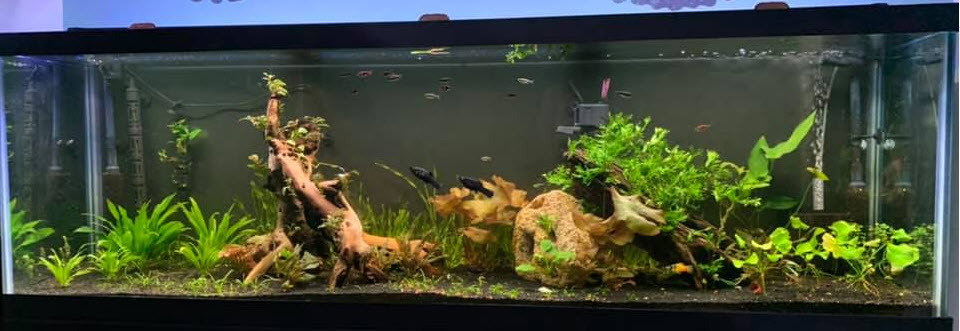
A Predicate
The most important variable when choosing a commercial dry food is the protein level. The higher the protein level in any food the healthier the fish. But this effect is NOT because eating high protein food is good for a fish. Rather the effect is due to what high protein food can do to the ecosystem that is in any aquarium. Higher protein food is a significant factor in creating crystal clear water. In turn, crystal clear water gives very healthy fish.
Note I personally simply buy the highest protein level I can find if I need to buy commercial pelleted fish food (I avoid flake food).
But it should also be noted that the BEST food is both homemade gel and Mazuri gel foods. Both of these are roughly 55% protein with very low carbohydrates. More information can be found in this article:
3.4. Homemade Gel Foods
And for those who are lazy, some human foods are far better foods for fish than commercially available foods. Grated or chopped beef heart, tilapia filet or shrimp all make excellent fish foods. Earthworms are also very good food for fish.
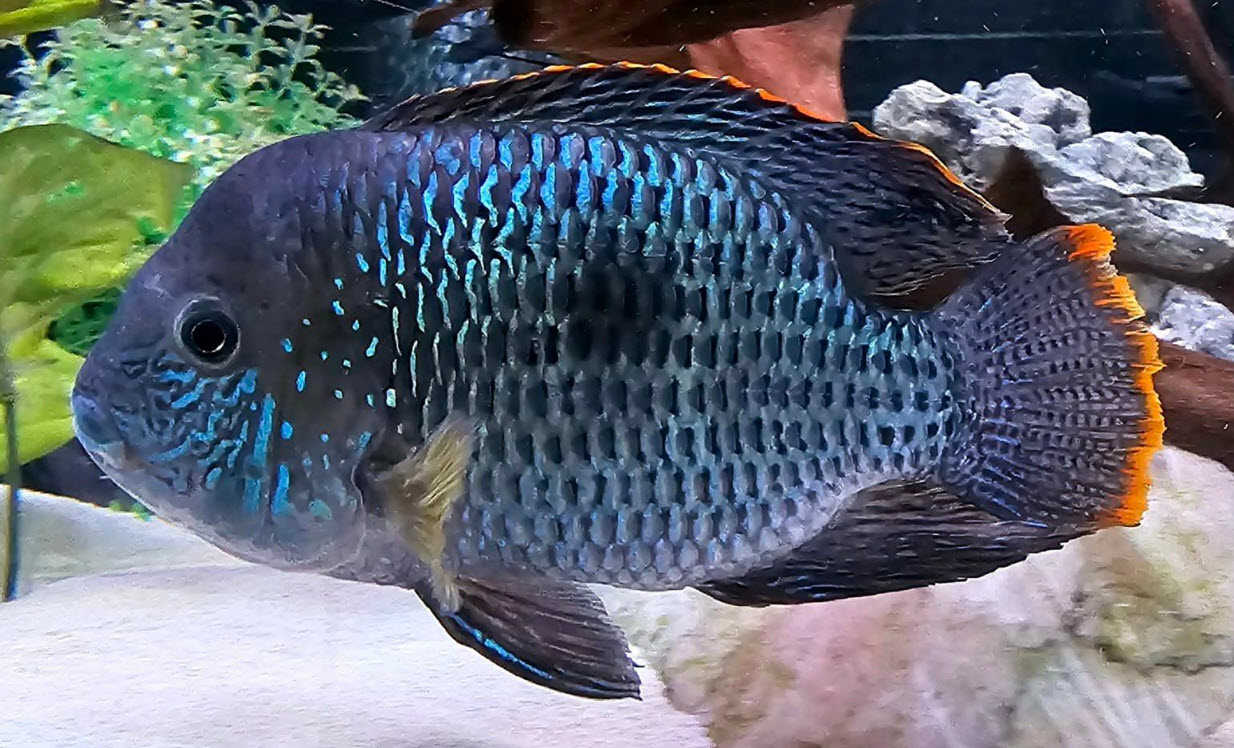
Fish Food in Depth
Now every fish owner wants his fish to be in the best health possible. But the bottom line is that fish food has little or no DIRECT effect on the health or longevity of aquarium fish. There are four slightly desirable characteristics only:
- For optimum juvenile growth rate, have over 40% protein
- For optimum fertility, have over 10% fat
- For optimum juvenile growth rate, have less than 30% cheap protein from the likes of soybeans
- For optimal juvenile growth rate, have at least one of the first ingredients in a fish food be “whole fish” or “fish meal”. This give juveniles the calcium and phosphorus they need for bone growth.
But it must be emphasized that this is all relative. Fish do just fine with food that is outside this range. All of the research found differences in the growth rate of juvenile fish and the fecundity of fish with foods at less than these levels. But the survival rates of the fish didn’t change with levels less than these “optimums”.
The reasoning behind these four requirements is simple. A growing juvenile fish needs about 40% of its food to be proteins to add muscle mass and to replace spent proteins. Only protein can be used to produce protein so the greater than 40% protein desired level for fastest growth of juveniles. The fish will grow better with 50% protein, but the difference is only really of note if you are growing the fish for profit in an aquaculture system.
Fat is required for forming eggs and sperm. Thus the requirement for a minimum of 10% fat in the diet for fish which are being bred.
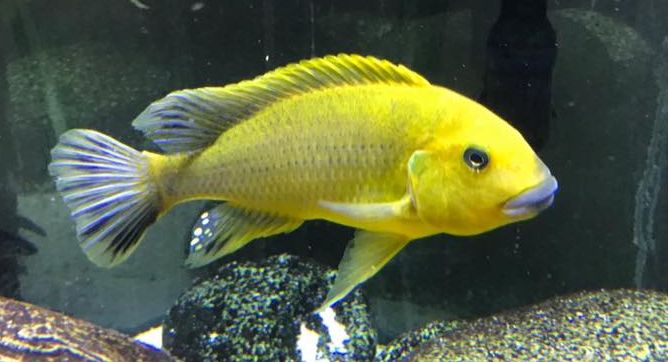
The remaining 50% of the food is used by the fish to produce energy for swimming, respiration, and bodily functions. A fish can produce energy from proteins, carbohydrates or fats. It makes little difference which type of food is the source of the calories. Thus the inherent flexibility in a fish as to its dietary requirements.
The limitation on soybean protein (or other cheap proteins like potato protein or wheat gluten) is because these proteins lack two essential amino acids. Fish that don’t get enough of these two amino acids will not grow at an optimum rate.
Note we like to have over 50% protein in any food we use due to the way waste accumulates in the aquarium but that is a desirable characteristic for fish in a very indirect way. We go into that in greater depth below.
We do not recommend any food with 50% or greater fillers. It just doesn’t seem right to pay a lot of money for fillers when there are many alternatives that have much less fillers.
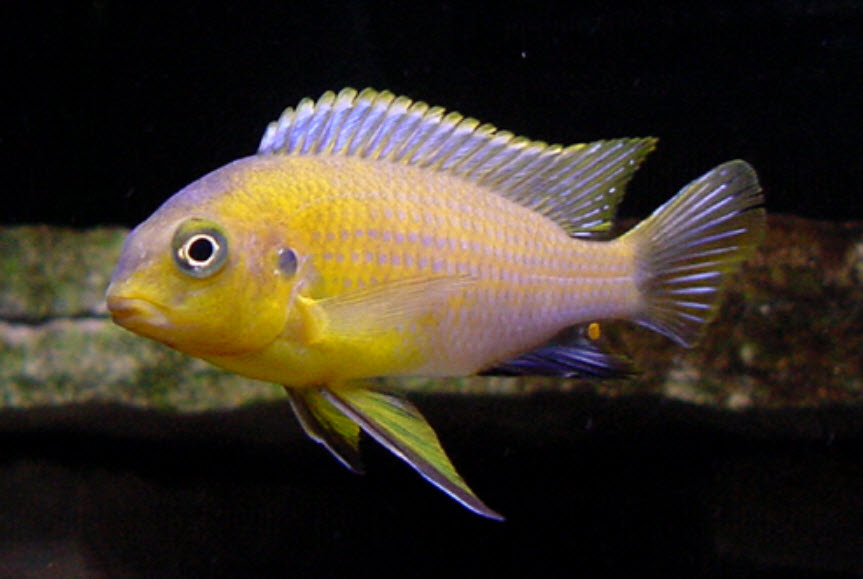
It should be noted that commercial tropical fish breeders in Florida buy their feed from commercial feed manufacturers who produce dry fish food by the ton that meet the four requirements above. These foods (save for various EXCELLENT Purina feeds) are not available to the home hobbyist.
Here are some popular fish foods, rated by protein level. Obviously the Aquamax 500 is the best food.
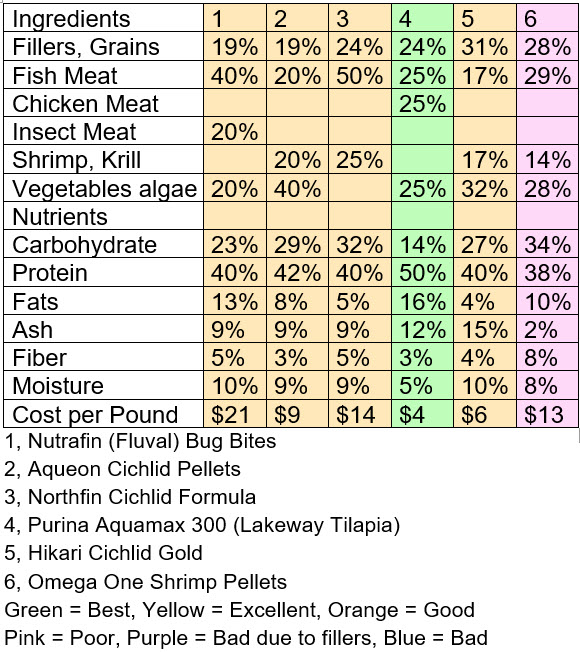
This chart is based on the protein level of the food
- Green best >50% protein
- Yellow excellent 45-49% protein
- Orange good 40-44% protein
- Pink poor 35-39% Protein
- Blue bad 30-35% protein
- Purple bad >50% filler
Here are more commercial dry fish foods
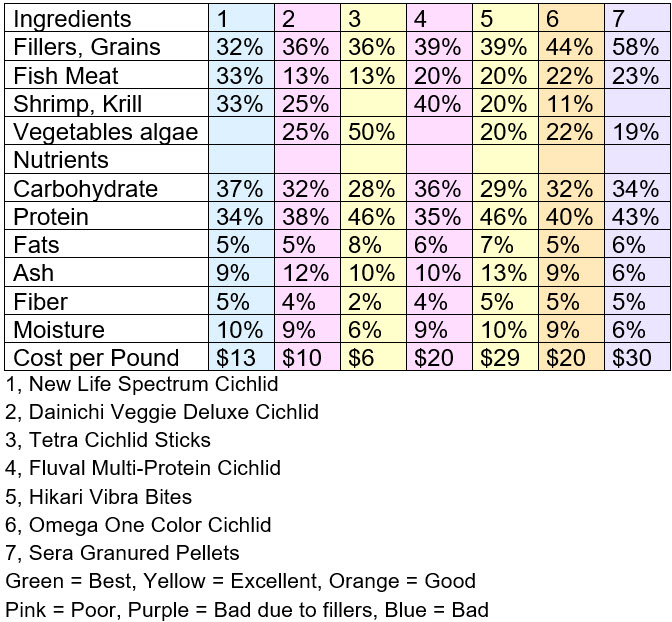
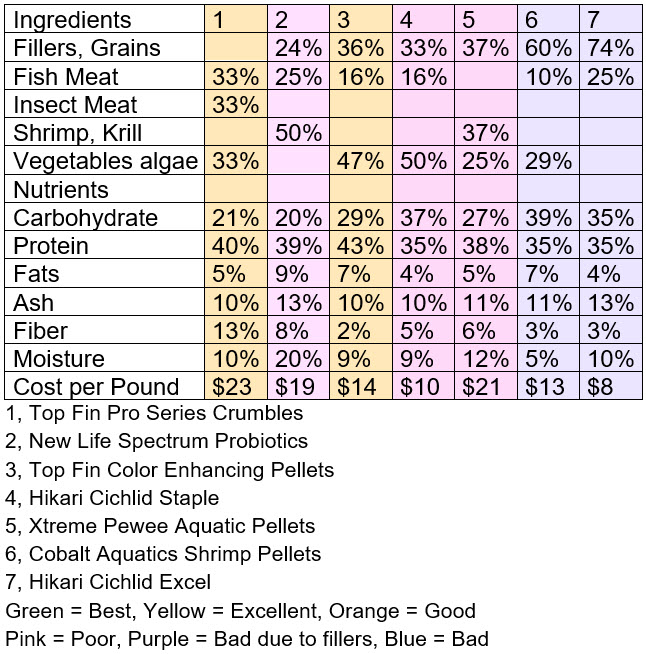
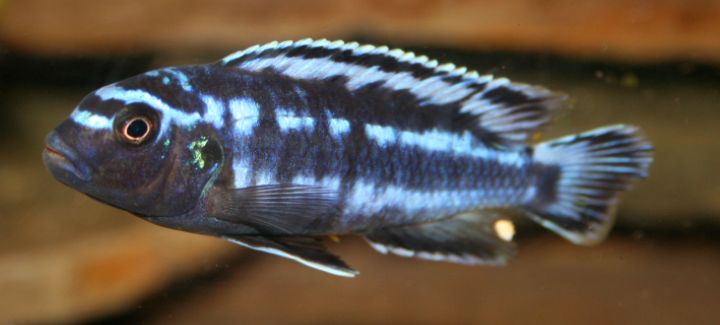
The percentage ingredients in the chart above are a judgement based on what is on the packages, their costs and the fact that the profit motive is a strong one. This analysis was done based on the way manufacturers list their ingredients. By law manufacturers must list the ingredients by the amount in the food. The first ingredient has the biggest percentage and on down. Note that the profit motive is such that typically the first three or up to eight ingredients are all in equal percentages and the rest of the ingredients are present in only minuscule quantities.
Prices are based on bulk buys of one to two pounds. The carbohydrate percentage is based on adding everything else up and subtracting from 100.
Veggie Foods
The same analysis can be done for commercial “veggie”, algae or spirulina fish foods
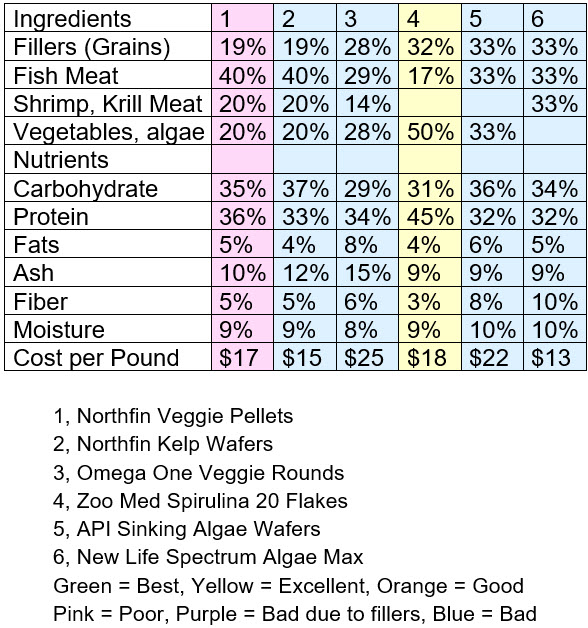
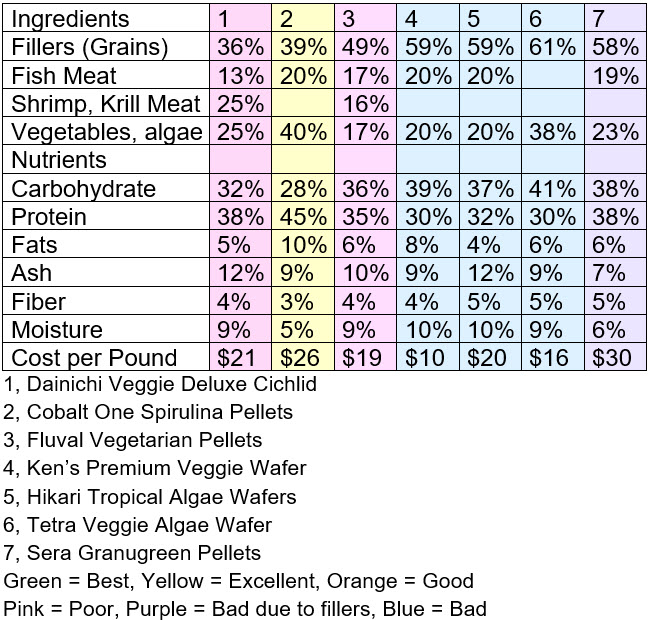
Obviously the vegetarian foods, by and large, are not as good as the other foods.
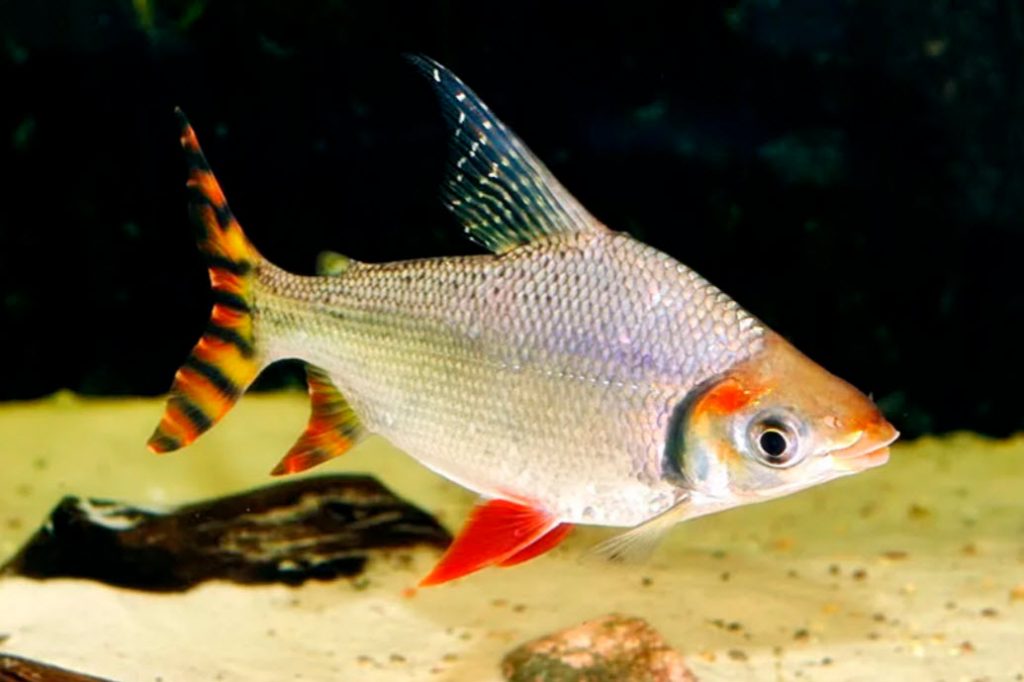
Flake Food
The same analysis can be done for flake foods.
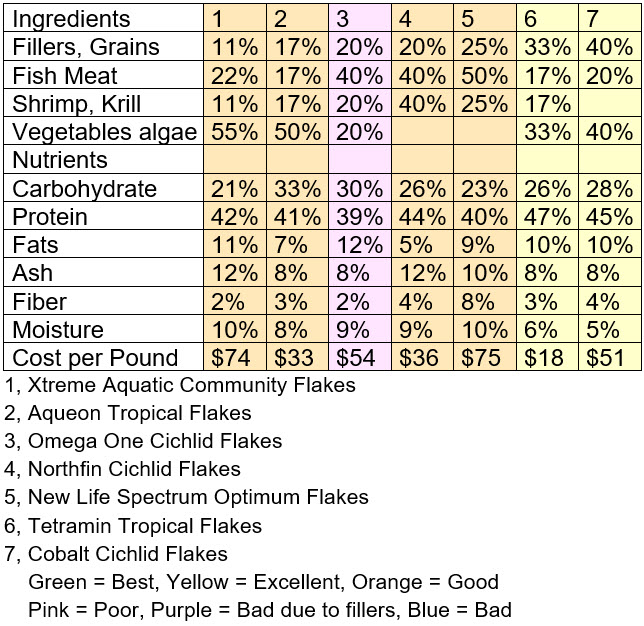
While the flaked foods are mostly “good” the price of flaked food is just ridiculous. Flaked food is largely air. On a per pound basis it is not something I can recommend. And since flake food tends to cloud the water more than pelleted food I recommend flake foods be avoided altogether.
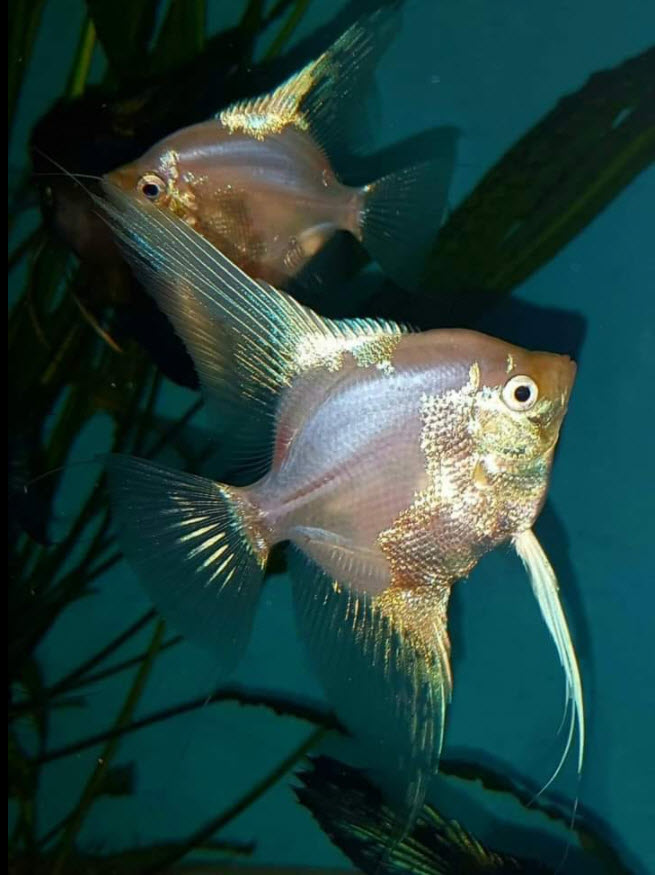
An Opinion on Proteins and Carbohydrates
The author currently uses a homemade gel food that is 55% protein to feed roughly five hundred Malawi Cichlids. If this food runs out for some reason my “go-to” commercial dry food (Purina Aquamax 300) is 50% protein. And my fish are healthy and never get Malawi bloat.
There are several reason I use a high protein food:
- Many fish in my tanks are still growing and need the protein for muscle mass growth
- “High protein” translates into “low carbohydrates” in most foods:
- Fish do not digest carbohydrates well. As a result, high carbohydrates cause “Malawi bloat” because of this inability to digest carbohydrates.
- High carbohydrates give a high “carbon to nitrogen ratio” in the aquarium. This in turn can give “dull” or even cloudy water. “Dull” or cloudy water is unhealthy for fish.
I would not use any of the pink, blue or purple foods in these charts. Any food with a protein level below 40% I will not use and do not recommend to any hobbyist. If I have to buy an off the shelf fish food I ALWAYS buy the fish food with the highest protein level available. And I refuse to pay good money for any product which is more than 50% cheap fillers.
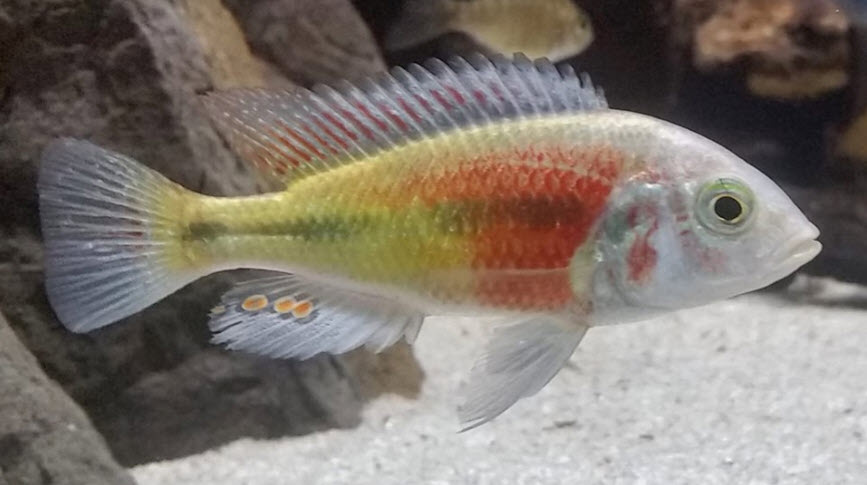
Ingredients List Analysis
Most ingredient lists follow a simple pattern, some moderately expensive ingredients such as fish meal followed by cheap fillers such wheat or potatoes, followed by some very expensive items like spirulina. Because of the profit motive the pattern of these ingredients is easily discerned. The first two categories of ingredients are what are in the tables above. Everything in these two categories is given equal weight. This reflects how these ingredient lists are formulated to maximize profits.
The amount of an expensive item such as spirulina for example might be only 0.001 %, so there is no point in including it. Most of the time most of the “ingredients” list is rather expensive food stuffs which are only present in tiny amounts. This can be illustrated by the ingredients list of Hikari Vibra Bites.

The fifth ingredient is a cheap waste product called “brewer’s yeast”. It is probably in the food in the same amount as the first four ingredients, a course of action which will maximize the profits of the manufacturer. The sixth ingredient in the formula is “cuttlefish meal”. Cuttlefish meal is very expensive and probably is in the formula only in very small amounts, again maximizing the profit for the manufacturer.
Because of the over-riding profit motive, the most likely composition of any fish food is equal portions of all the moderately expensive ingredients and the inexpensive ingredients. This maximizes the profit for the manufacturer. Contrary to some people’s thoughts, these fish food manufacturers are in business to make a profit and ONLY to make a profit.
In order to satisfy some perfectionists that don’t seem to understand the term “approximation” 1% was deducted from the wheat and starch amount to account for all the very expensive ingredients some folks are sure are in that food in significant quantities. Note this is being very generous, these ingredients are quite expensive and simply won’t be in the food in significant quantities.
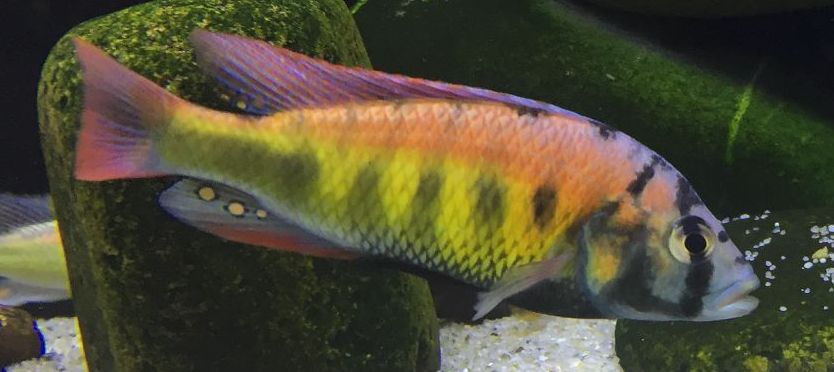
How is Fish Food Made?
The process for most pet food is simple. Roughly one plastic gaylord of material, about 1,200 pounds, is mixed dry in a very large mixer. The first few components are added in fifty-pound bags by an operator. In a fish food this might be 25% sardine meal, 25% krill, 25% soybean, and 25% wheat flour. Then a small container is brought out with ALL the other ingredients. Maybe one cup of this expensive material is added. That is an ounce or two in 2,000 pounds of material, or a total of roughly 0.005% for ALL the remaining ingredients.
This is perfectly legal. There is no minimum amount for an ingredient to be listed on the label. This process maximizes the profits for the manufacturer.
To illustrate the approximation process, look at the ingredients list for Tetra Cichlid Sticks.
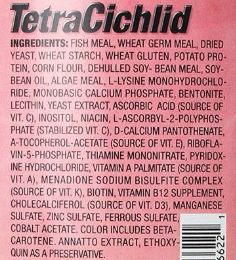
The only ingredient in Tetra Cichlid Sticks likely to constitute the bulk of this food are the eight leading up to the Soybean Oil. They are:
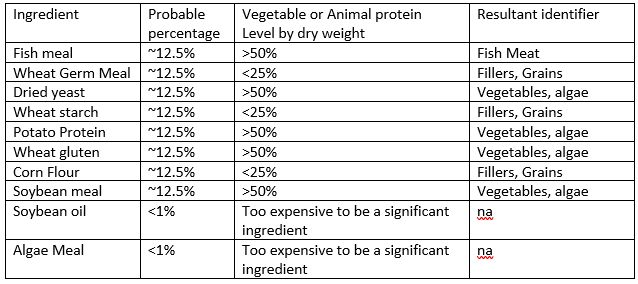
This gives 37% Fillers, Grains, 12% Fish meat, and 50% Vegetables, algae. Simple math based on maximizing the manufacturers’ profit.
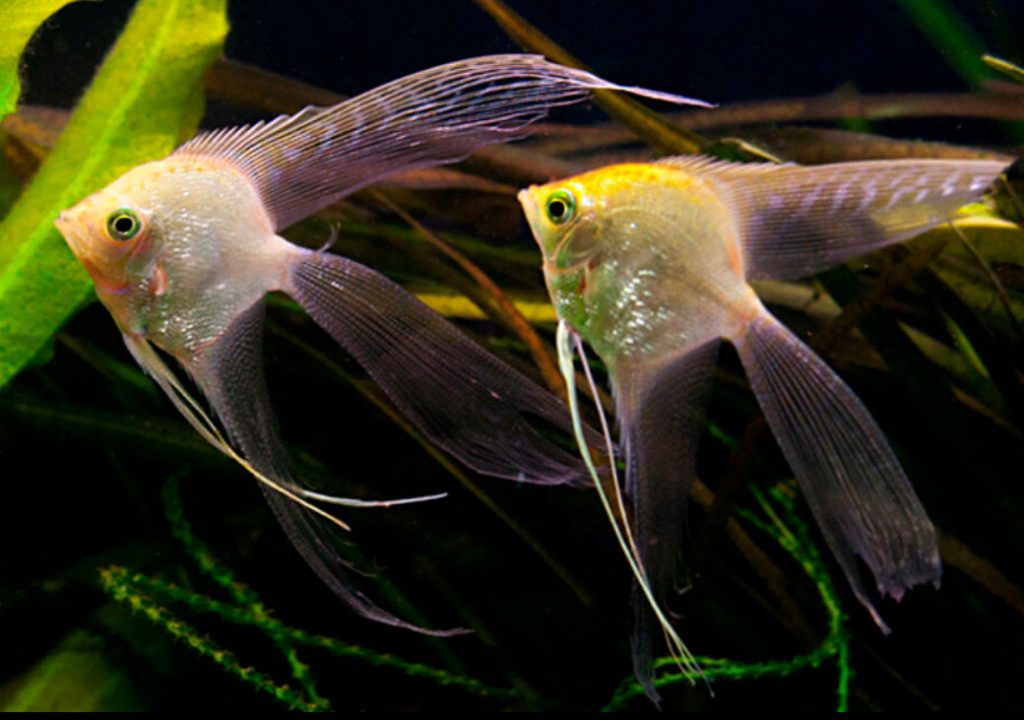
What Maximizes the Profit Margin?
Now some dispute this analysis. One group says that the manufacturers of fish food use gradually smaller amounts of the first eight or so items. Let’s look at the profit that accrues. Fish food is typically manufactured in roughly 1,200-pound batches using 24 fifty-pound bags:
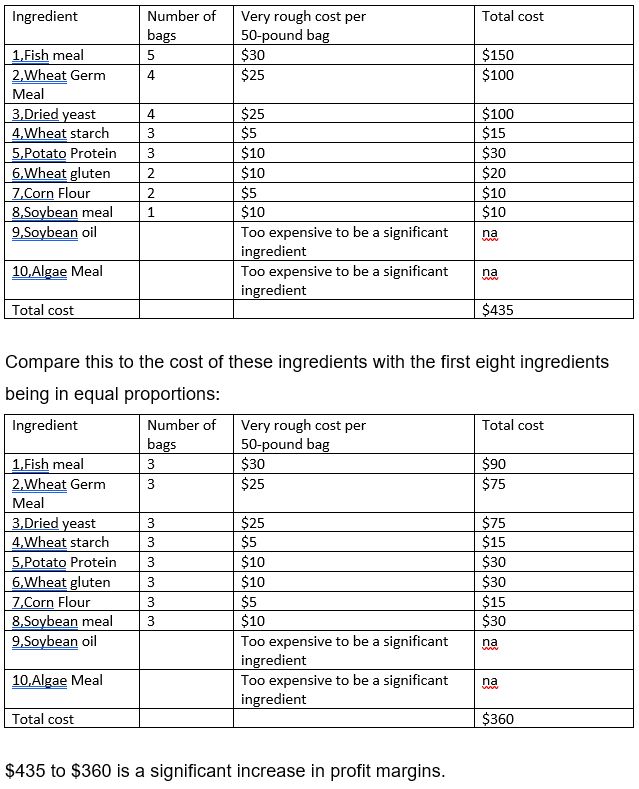
Now there are also those who claim that all the ingredients will be in the formulation in significant amounts. So what would that look like?
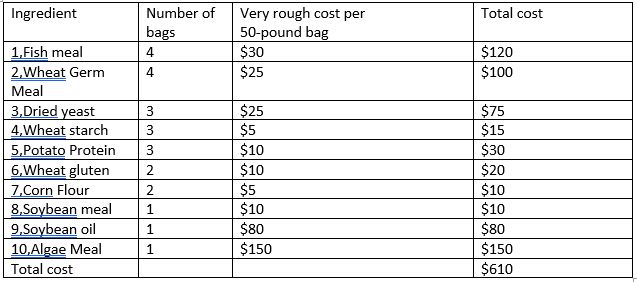
$610 to $360 is an even larger increase in profit margins. It cannot be emphasized enough that manufacturers are not in business for altruistic ends like improving the health of a hobbyist’s fish. They are in business to make money, period.
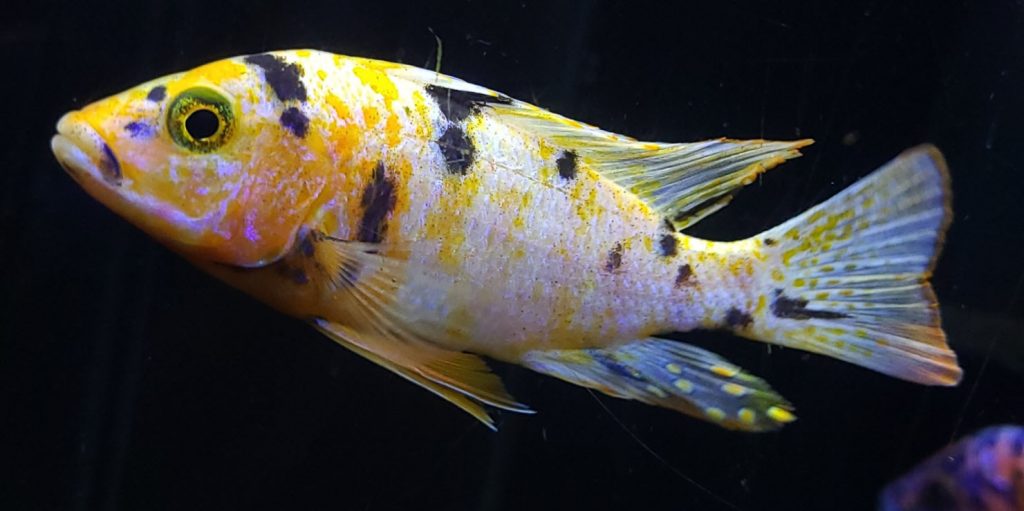
“Vegetables”
The vegetable portion of the ingredients takes a little understanding. All the “vegetables” are foods rich in vegetable protein, like soybeans, wheat gluten (yes, gluten is largely protein, not carbohydrate!), yeast and potato protein. It does not include such things as wheat germ. A reference is in order (“Today’s and Tomorrow’s Feed Ingredients in Norwegian Aquaculture”, Sørensen et. al., 2011):
“Increasing competition and peaking ingredient prices of major resources used in salmon farming is calling for a review of resources being used today and potential resources that will be used in near future. A vast amount of experiments are carried out over the last two decades in evaluating potential alternatives to fish meal and fish oils in diets for salmonids. The main focus has been on ingredients derived from either plant origin (Thomassen and Røsjø, 1989; Rosenlund, et al., 2001; Gatlin, et al., 2007; Hemre, et al., 2009; Gunstone, 2011), terrestrial animal origin (Bureau, et al., 1999; Turchini, et al., 2009), Krill, Amphipods and Copepods (Olsen, et al., 2010) or single cell organisms from bacterial meal (Øverland, et al., 2010), yeast and algae (Skrede, et al., 2011). The current plant protein ingredients being used by the Norwegian aquaculture industry include soybean meal, sunflower meal, pea protein concentrate, beans, wheat gluten and corn gluten”.
This explains why the scorned Tetra food (one woman claimed fish would be dead in a day if your fed them Tetra food!) actually has a decent protein/carbohydrate ratio and does not appear to be bad for fish at all.
Mislabeled Products
In many reviews made of many commercial fish foods there was only one food that was obviously mislabeled, namely New Life Spectrum Algae Max. One set of batches of New Life Spectrum Algae Max (the large containers) had the following analysis on the package:
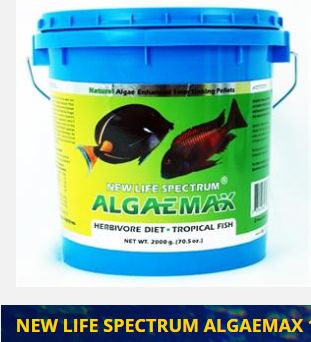

Since whole wheat flour is a cheap ingredient and “algae” is an expensive ingredient the profit motive thus dictates an analysis of 33% fish, 33% shrimp, and 33% fillers. This is the analysis used in the above chart.
But in smaller quantities the ingredients list is much different:
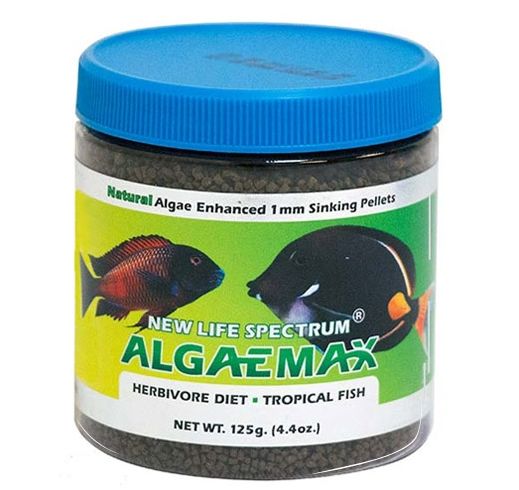
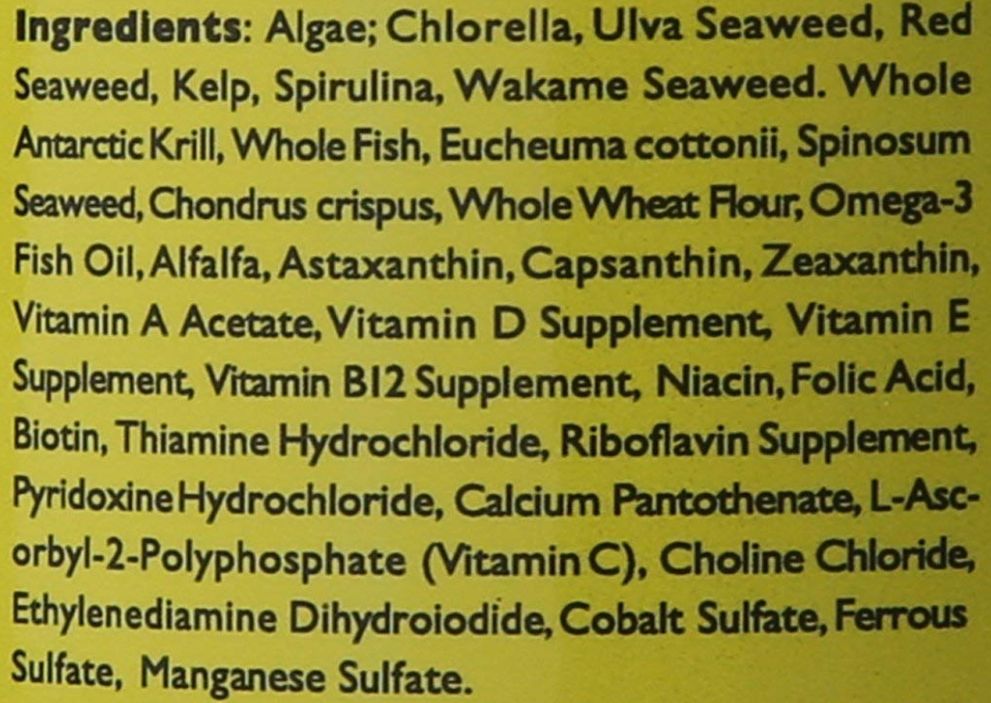
This analysis is obviously in error. There are twelve ingredients leading up to and including the wheat flour. Nine of those ingredients are very expensive seaweed and algae. This would mean at least 75% of this fish food is very expensive ingredients. This just won’t happen. New Life Spectrum would be losing money on every jar sold.
The punctuation is interesting. One could surmise the first six ingredients, taken as a whole, are a sizable portion of the analysis. But then there are three very expensive seaweeds outside the punctuation. The analysis on the larger container is the accurate analysis.
The science behind the definition of “optimum” dry foods for fish is based on the journal articles and research found in this link:
3.1.1. Fish Food Science
There are a lot of myths about the analysis of fish foods These myths are covered in this section:
3.7. Banned Fish Food
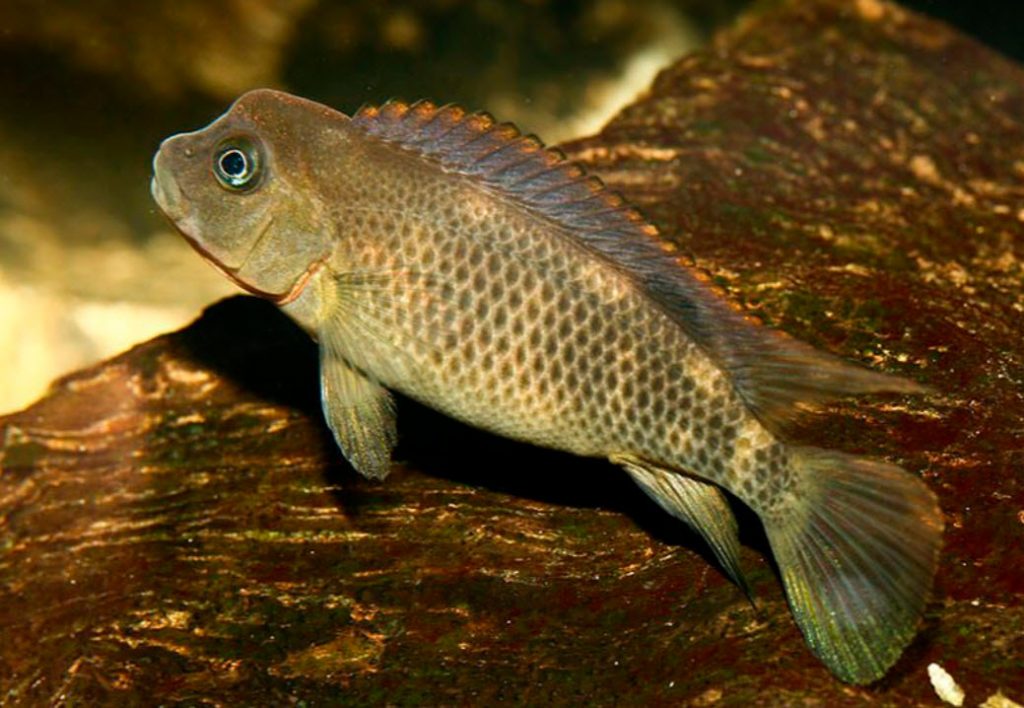
.
Return to Fish Food Menu
.
Aquarium Science Website
The chapters shown below or on the right side in maroon lead to close to 400 articles on all aspects of keeping a freshwater aquarium. These articles have NO links to profit making sites and are thus unbiased in their recommendations, unlike all the for-profit sites you will find with Google. Bookmark and browse!
.
